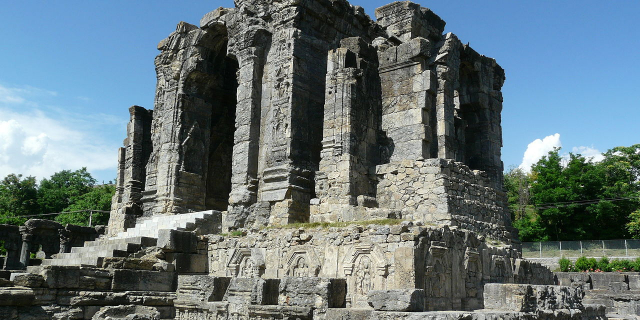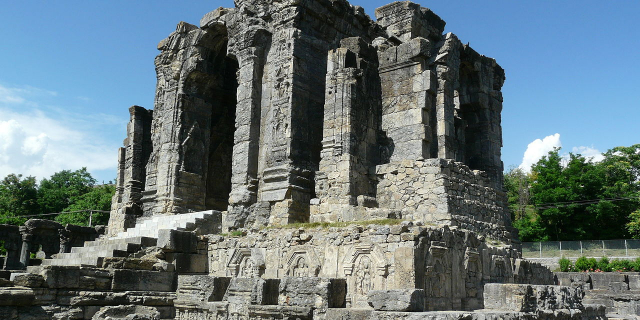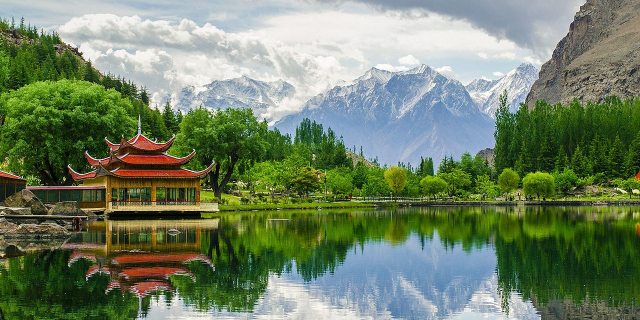Srinagar (English: , Kashmiri pronunciation: [siriːnagar]) is a city in Indian-administered Jammu and Kashmir in the disputed Kashmir region. It is the largest city and summer capital of Jammu and Kashmir, which is an Indian-administered union territory. It lies in the Kashmir Valley along the banks of the Jhelum River, and the shores of Dal Lake and Anchar Lakes, between the Hari Parbat and Shankaracharya hills. The city is known for its natural environment, various gardens, waterfronts and houseboats. It is also known for traditional Kashmiri handicrafts like the Kashmir shawl (made of pashmina and cashmere wool), papier-mâché, wood carving, carpet weaving, and jewel making, as well as for dried fruits. It is the second-largest metropolitan area in the Himalayas (after Kathmandu, the capital of Nepal).
Founded in the 6th century during the rule of the Gonanda d...Read more
Srinagar (English: , Kashmiri pronunciation: [siriːnagar]) is a city in Indian-administered Jammu and Kashmir in the disputed Kashmir region. It is the largest city and summer capital of Jammu and Kashmir, which is an Indian-administered union territory. It lies in the Kashmir Valley along the banks of the Jhelum River, and the shores of Dal Lake and Anchar Lakes, between the Hari Parbat and Shankaracharya hills. The city is known for its natural environment, various gardens, waterfronts and houseboats. It is also known for traditional Kashmiri handicrafts like the Kashmir shawl (made of pashmina and cashmere wool), papier-mâché, wood carving, carpet weaving, and jewel making, as well as for dried fruits. It is the second-largest metropolitan area in the Himalayas (after Kathmandu, the capital of Nepal).
Founded in the 6th century during the rule of the Gonanda dynasty according to the Rajatarangini, the city took on the name of an earlier capital thought to have been founded by the Mauryas in its vicinity. The city remained the most important capital of the Kashmir Valley under the Hindu dynasties, and was a major centre of learning. During the 14th–16th centuries the city’s old town saw major expansions, particularly under the Shah Mir dynasty, whose kings used various parts of it as their capitals. It became the spiritual centre of Kashmir, and attracted several Sufi preachers. It also started to emerge as a hub of shawl weaving and other Kashmiri handicrafts. In the late 16th century the city became part of the Mughal Empire, many of whose emperors used it as their summer resort. Many Mughal gardens were built in the city and around Dal lake during this time, of which Shalimar and Nishat are the most well-known.
After passing through the hands of the Afghan Durranis and the Sikhs in the late 18th and early 19th century, it eventually became the summer capital of the Dogra kingdom of Jammu and Kashmir in 1846. The city became a popular tourist destination among Europeans and Indian elites during this time, with several hotels and its iconic houseboats being built. In 1952, the city became the summer capital of Jammu and Kashmir, a region administered by India as a state, with Jammu being its winter capital. It was the flashpoint of violence during the 1990s and early 2000s insurgency in the region. In 2019, it became the summer capital of a smaller region which is administered by India as a union territory, after the former state's reorganisation.
 An 8th century Hindu temple at Pandrethan, in the vicinity of present-day SrinagarEarly History
An 8th century Hindu temple at Pandrethan, in the vicinity of present-day SrinagarEarly History
According to the Rajatarangini of Kalhana, a capital city by the name of Srinagari was built in the Kashmir valley by Ashoka.[a] Kalhana calls this capital puranadhisthana, Sanskrit for ‘old capital’, identified as present-day Pandrethan, 3.5 kilometres south-east of Srinagar.[1] A ‘new capital’ was built by king Pravarasena, called Parvarapura, in 6th century CE. Srinagari continued to be used as a name for this capital. This new capital was located at the base of the Hari Parbat hill on the right bank of the Jhelum, corresponding to the location of modern-day Srinagar.[3] Kalhana describes the capital having several markets, mansions, wooden houses, grand temples and canals, and also refers to the Dal lake and Jhelum river.[4] A long embankment was constructed on the Jhelum by Pravarasena to protect the city from floods, parts of which have survived to the present day.[5] The two capitals are also mentioned in the chronicle of Chinese traveller Huein Tsang who visited the city in 631 CE.[6][7] Although several other capitals of Kashmir were constructed by other rulers over the next few centuries, Pravarasena’s Srinagar survived as the capital.[b] The city was divided into several parts, each with its own guardian deity, which continue to be worshipped by Hindu Kashmiris.[9] The 8th century scholar Adi Shankara visited the city and founded the Shankaracharya Temple here, at the site of the earlier Jyeshteshwara Temple.[10] The city gradually extended to the left bank of the Jhelum river, and in the early 12th century the royal palace was shifted to this side.[11]
Sultanate period The Jamia Masjid in Srinagar, built in the beginning of 15th century CE
The Jamia Masjid in Srinagar, built in the beginning of 15th century CERinchana, a Buddhist convert to Islam who briefly ruled Kashmir in the early 14th century, built the first mosque in Kashmir on the site of a Buddhist temple in a colony of Srinagar built by him.[12] The Muslim rulers that came after him established their capitals in areas of present-day old city Srinagar.[13] During the rule of the Sultans, the city became synonymous with the Kashmir valley, and 'Srinagar' fell into disuse as a name for it.[c][11] During the rule of Qutbuddin, Islamic preacher Mir Sayyid Ali Hamadani visited the valley and established his seat of preaching in Srinagar. Sultan Sikandar Shahmiri (1389–1413 CE) built the Khanqah-e-Moula at this location, and also built the Jamia Mosque at Nowhatta in 1402.[14] The oldest surviving example of forcible conversion of a Hindu place of worship into Muslim shrine in Kashmir also appears from Srinagar under Sikandar’s rule.[15] Sikandar’s successor Zain-ul-Abidin undertook several constructions in and around Srinagar. He built the Zainakadal bridge connecting the two halves of the city on either side of the Jhelum river, the Mar canal and two islands inside Dal lake called Sona Lank and Rupa Lank.[16] He also built a stone shrine for his Islamic teacher at Madin Sahib, and a brick mausoleum for his mother constructed using materials from a Hindu structure and showing Timurid influences,[17] where he was also buried after his death. He is also credited with establishing industries around the arts of shawl and carpet weaving, papier-maché, and wood carving in Srinagar.[18]
Mughal rule Nishat Bagh, a Mughal Garden built during the reign of Shah Jahan on the northern bank of the Dal lake, in the vicinity of Srinagar
Nishat Bagh, a Mughal Garden built during the reign of Shah Jahan on the northern bank of the Dal lake, in the vicinity of SrinagarThe Mughals annexed Kashmir in 1586 after a period of internal instability in the valley, and added it to their Kabul province. Mughal emperor Akbar visited the valley three times. During his second visit in 1592, an elaborate Diwali celebration was held in Srinagar.[19] On the final such visit, he was accompanied by the first recorded European visitors to the area.[d] Akbar built fortifications around the Hari Parbat hill, and established a township called Nagar Nagar there.[20] He also built a shrine for Hamza Makhdoom, a Sufi mystic of Kashmir's Rishi order, on the southern slope of Hari Parbat which was later expanded several times.[21] His successor Jahangir was particularly fond of the Kashmir valley and frequently visited it.[20] His rule brought prosperity to Srinagar, and several Mughal gardens were built in the city and around the Dal lake during his and his successor Shah Jahan's reign, including the Shalimar and Nishat Bagh. Empress Nur Jahan built the Pathar Mosque on the left bank of Jhelum river opposite the Khānqāh-e-Moula in 1623, the mosque was however deemed unfit for worship soon after its construction and used instead for non-religious purposes.[22] Shah Jahan made Kashmir into a separate Subah (province) with its administrative seat at Srinagar in 1638. The Aali Masjid was built during the reign of Aurangzeb (1658–1707), as was the Safa kadal bridge over the Jhelum. The moi muqaddas, a relic believed to be the hair strand of prohphet Muhammad’s beard, also arrived in Kashmir during this time, and was housed in a Mughal palace at Hazratbal, which became the Hazratbal Dargah. A number of Europeans visited the city during the later Mughal period.[e]
Afghan and Sikh ruleIn 1753, Kashmir passed into the hands of the Afghan Durrani Empire. The Afghans undertook reconstructions in Srinagar and built the palace at Shergarhi at the site of a pre-existing ancient palace, as well as the fort atop Hari Parbat.[24] However, contemporary accounts describe the city as filthy and deteriorating, and it also saw worsening inter-community relations during Afghan rule, with repeated Hindu-Muslim and Shia-Sunni riots, and state persecution of Pandits.[25] In 1819, the Sikh Empire assumed control of Kashmir. Under them, Srinagar, the old name of the city, was restored. The situation in the city did not improve much under Sikh rule, and the city remained in a state of decay.[26] They also imposed several restrictions on Muslim religious expression, and closed the gates of the Jamia Mosque, which remained closed until 1843. A Shia-Sunni riot happened in the city in 1837.[25]
Dogra ruleWith the establishment of Dogra rule following the 1846 Treaty of Amritsar, Srinagar became the capital of the princely state of Jammu and Kashmir. Taxes were increased and the production of silk, saffron, paper, tobacco, wine, and salt, as well as the sale of grain, became the monopoly of the state. It was a capital offence for a Muslim to kill a cow as late as the 1920s; later, the penalty was reduced to ten years of imprisonment and still later to seven years (Section 219 of Ranbir Penal Code).[27] The Dogras found Srinagar deteriorating, filthy and overcrowded.[28] The city used to see several break-outs of cholera, as well as earthquakes, floods, fires and famines. The famine of 1877–79 is said to have halved the city’s population.[29] Consequently, due to the famine and forced labour in the villages, a considerable number of people migrated to Srinagar.[30]
The Darbar Move was introduced in 1872 by Ranbir Singh, whereby the capital moved to Jammu for six months during the winter[31] albeit later phased down by Hari Singh who "fixed his headquarters permanently at Jammu". The Ministers and Heads of Departments continued to followed it, nevertheless, it was still a move which was resented by Kashmiris, particularly Pandits.[32] The Raghunath Temple was also completed during Ranbir Singh's rule.[33] With a global decline in shawl trade during late 19th century, the shawl weaving class of the city was upended. Several changes were ushered in during the reign of Pratap Singh (1885–1925). A British Residency was established in Srinagar and direct British influence on the administration of the state grew. During this time, Srinagar, and in turn the Kashmir Valley, was connected to the rest of India via roads, which saw increased trade with Punjab. In 1886, a municipality was established for the city of Srinagar.[34] Works for sanitation and urban development undertaken by the municipality were often met with stiff opposition by the residents, who were averse to changes.[35] In the late 19th and early 20th century, modern tourism began to take hold in the city, especially on and around the Dal lake, with houseboats being built to accommodate British officers and their families who came in the summers seeking respite from the heat of the plains of northern India.[36] The Shergarhi Palace was greatly modified by the Dogras, who used it as their official residence in the city. Pratap Singh and his successor Hari Singh also laid out several parks in the city. The city expanded rapidly between 1891 and 1941, partly due to increased migration from the countryside as a result of famines and due to improvements in sanitation and urban development as well as economic expansion, in particular the growth of the textile and tourism industries in the city.[37] Many Punjabis also settled in Srinagar during this time for trade, commerce and administration.[38][39]
Srinagar emerged as the hub of political activity within the Kashmir valley during later Dogra rule. Kashmiris at large despised the Dogra rule and considered the dynasty an "alien rule".[40] Many Muslim leaders competed for influence and control over Muslim shrines in the city through which they sought to become representatives of Kashmiri Muslims.[41] Sheikh Abdullah, and his National Conference (NC), eventually succeeded in doing so.
Partition and IndependenceIn 1947, after the princely state’s accession to India following an invasion of the state by Pakistani irregulars in the aftermath of the partition of India, Indian forces were airlifted to Srinagar on 27 October to defend the city and the larger Kashmir valley.[42] The National Conference also established a popular people’s militia in the city to aid the army in their defence of the territory.[43][44] Srinagar became the summer capital of the Indian state of Jammu and Kashmir when it was established in 1952.
In 1963–1964, the relic at the Hazratbal Shrine in Srinagar briefly disappeared, causing political turmoil.[45] Following this, the shrine was reconstructed between 1968 and 1979 in a Mughal-inspired style.[46] In 1989, Srinagar became the focus of the insurgency in Jammu and Kashmir. The city saw increased violence against the minority Hindus—particularly the Kashmiri Pandits—during the insurgency which resulted in their ultimate exodus.[47][48] Kashmiri Hindus constituted 21.9% of Srinagar's population in the 1891 census and 2.75% in the 2011 census.[49] The Gawakadal massacre took place in the city in January 1990, resulting in 50–100 deaths.[50] As a result, bunkers and checkpoints are found throughout the city, although their numbers have come down in the past few years as militancy has declined. However, protests still occur against Indian rule, with large demonstrations happening in 2008, 2010, 2013, and 2016.[51][52] After revocation of the special status of Jammu and Kashmir and the subsequent devolution of the state into a union territory in August 2019, a lockdown was imposed in Kashmir, including in Srinagar.[53]
Cite error: There are <ref group=lower-alpha> tags or {{efn}} templates on this page, but the references will not show without a {{reflist|group=lower-alpha}} template or {{notelist}} template (see the help page).









































Add new comment